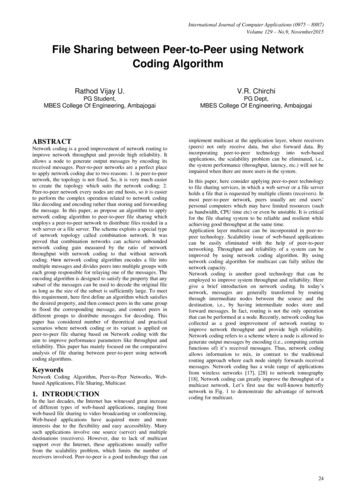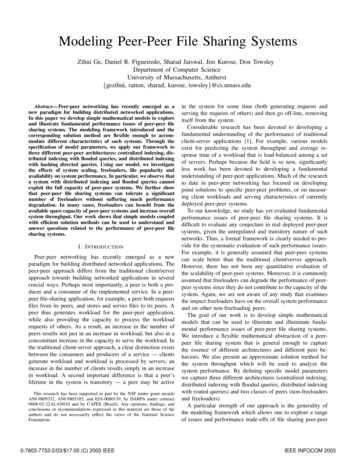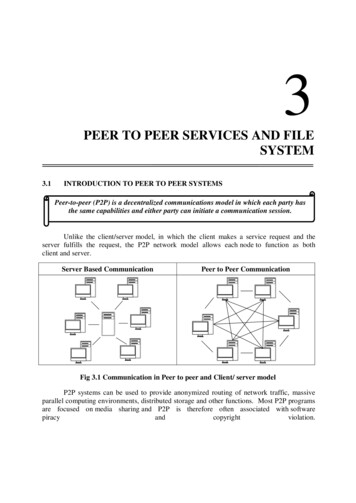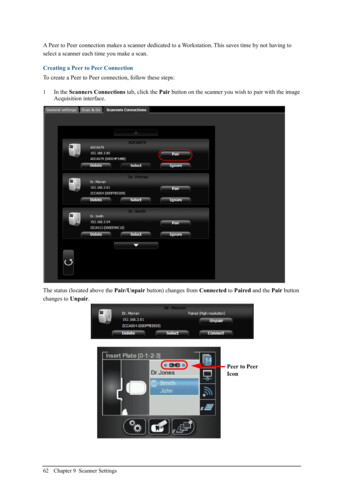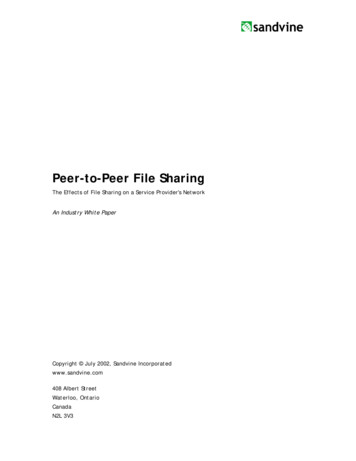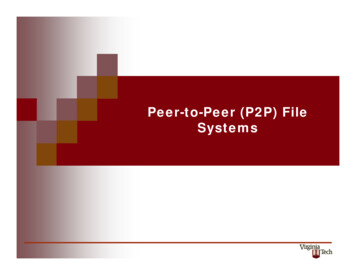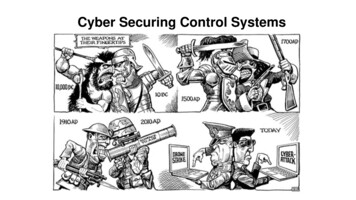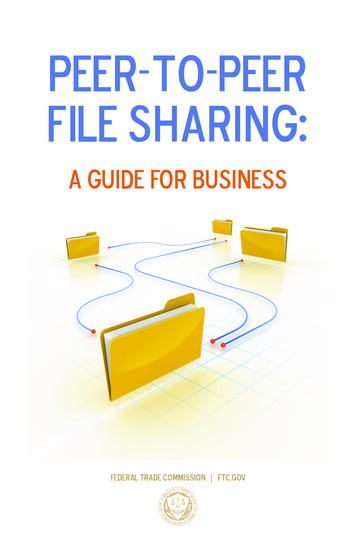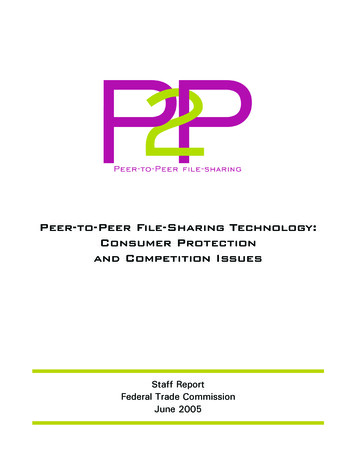
Transcription
Peer-to-Peer File-Sharing Technology:Consumer Protectionand Competition IssuesStaff ReportFederal Trade CommissionJune 2005
Peer-to-Peer File-Sharing Technology:Consumer Protectionand Competition IssuesFEDERAL TRADE COMMISSIONDeborah Platt Majoras, ChairmanOrson Swindle, CommissionerThomas B. Leary, CommissionerPamela Jones Harbour, Commissioner(Jon Leibowitz, Commissioner, not participating)Report ContributorsKial S. Young, Northwest Regional OfficeBeverly J. Thomas, Bureau of Consumer Protection, Division of Advertising PracticesThomas B. Pahl, Assistant Director, Bureau of Consumer Protection,Division of Advertising PracticesMary K. Engle, Associate Director, Bureau of Consumer Protection,Division of Advertising PracticesTheodore A. Gebhard, Bureau of Competition, Division of Policy and CoordinationHajime Hadeishi, Bureau of Economics, Division of Consumer ProtectionNicholas Gunn (Intern), Northwest Regional Office
Federal Trade CommissionTABLE OF CONTENTSEXECUTIVE SUMMARY.1I. INTRODUCTION .3II. P2P TECHNOLOGY AND ITS USES .3A. What Is P2P?.3B. How Does P2P Work? .41. Napster .42. FastTrack Protocol .43. BitTorrent .4C. Current Uses of P2P Technology .51. Commercial Uses .52. Non-commercial Uses.5D. Future Uses of P2P Technology .6E. Who Uses P2P?.7III.CONSUMER PROTECTION ISSUES .7A. Consumer Risks Related to Downloading and Using P2P Software Programs .71. Identification and Quantification of Specific Risks .8a. Data Security: Inadvertent File Sharing .8b. Spyware and Adware .8c. Viruses .9d. Liability for Copyright Infringement.9e. Pornography.10i. Inadvertent Exposure to Pornography .10ii. Liability for Distributing Pornography.112. Comparison of Risks Posed by P2P File Sharing and Risks Posed by Other InternetTechnologies .113. Consumer Awareness of Risks .12B. Industry Responses to P2P File-Sharing Risks .131. Development and Deployment of Technologies .13a. Blocking Technologies to Prevent Downloading of P2P Software .13b. Structural Changes to Address Risk of Inadvertent File Sharing .14c. Anti-spyware Technology.14d. Filtering Technologies to Address Other Risks .15i. Viruses .15ii. Copyright Infringement .15iii. Pornography.16
Federal Trade Commission2. P2P Software Industry Risk Disclosures .17C. Government Responses to P2P File-Sharing Risks .191. Law Enforcement and Other Legal Action .19a. Recent and Ongoing Law Enforcement.19b. Further Law Enforcement and Related Action .19i. Failure to Disclose Risk Information.20ii. Misleading or Deceptive Claims .202. Consumer Education.213. Industry Self-Regulation.214. Legislation.21IV. ECONOMIC IMPACT OF P2P FILE SHARING: COMPETITION ANDINTELLECTUAL PROPERTY ISSUES .22A. General Economic Effects of New Technology.22B. Asserted Effects of P2P File-Sharing Technology on the Music Industry.22C. Continuing Evolution of P2P File-Sharing Programs.24V. CONCLUSION .26ENDNOTES .APPENDIX AAgenda, “Peer-to-Peer File-Sharing Technology: Consumer Protection and CompetitionIssues” Workshop, December 15-16, 2004APPENDIX BConsumer Disclosure Working Group, “Peer-to-Peer (P2P) Software Risks: StandardizedConsumer Disclosures Solution to be Universally Applied by Complying P2P SoftwareSuppliers”APPENDIX CP2P United, Proposed Risk Disclosures27
Federal Trade CommissionEXECUTIVE SUMMARY1On December 15 and 16, 2004, the Federal Trade Commission (“FTC”) held a publicworkshop entitled “Peer-to-Peer File-Sharing Technology: Consumer Protection andCompetition Issues.”2 The two-day workshop explored a wide range of issues relating to peerto-peer – or “P2P” – file-sharing technology, and included seven panels featuring more than40 representatives from the P2P file-sharing software industry, entertainment industry, hightechnology research firms, government agencies, academic institutions, and consumer groups.Panel topics included:#P2P and How it Works;#Risks to Consumers Related to P2P File-Sharing Activities;#Technological Responses to Protect Consumers Using P2P File-Sharing Programs;#Government and Private Sector Responses to Protect Consumers Using P2P FileSharing Programs;#The Future of P2P Technology: Effects on Efficiency and Competition;#P2P File Sharing and Its Impact on Copyright Holders; and#P2P File Sharing and Music Distribution.The workshop was the latest chapter in the Commission’s continuing effort to assess theimpact of new technologies on consumers and businesses.3 While these technologies confersignificant benefits, they also pose risks to consumers. The technologies also present new legaland policy challenges, including how to protect property rights, privacy, and the competitiveprocess while still allowing creativity and innovation to thrive.4 Through the workshop, theCommission sought to explore and better understand the complicated issues arising from P2Ptechnology, and to inform the public debate about its use and development.5Together with FTC Chairman Deborah Platt Majoras, Senator Gordon Smith, thenChairman of the Competition, Foreign Commerce, and Infrastructure Subcommittee of theSenate Commerce Committee, provided some opening remarks at the workshop.6 Among otherthings, Senator Smith highlighted the substantial number of consumers – tens of millions in all– who use P2P file-sharing software programs to exchange files, and the need to educate theseconsumers about potential risks they face when using such programs.7FTC staff has prepared this report to present information concerning the consumerprotection, competition/economic, and intellectual property issues discussed at the workshop.Based on the information received in connection with the workshop and other availableinformation, FTC staff concludes:#P2P technology enables users to share communications, processing power, and datafiles with other users. Use of P2P technology can enhance efficiency by allowing faster1
Federal Trade Commissionfile transfers, conserving bandwidth, and reducing or eliminating the need for centralstorage of files.#P2P technology has a variety of applications. Currently, the most common applicationby far is commercial file-sharing software programs used by consumers to exchangefiles, such as music and movie files, with others.#P2P technology continues to evolve in response to market and legal forces. It appearslikely that the uses of P2P technology will expand in the future.#Consumers face risks when using commercial P2P file-sharing software programs,including risks related to data security, spyware and adware, viruses, copyrightinfringement, and unwanted pornography.#Many of these risks to consumers are not unique to P2P file sharing, but also existwhen consumers engage in other Internet-related activities such as surfing websites,downloading software, and using e-mail or instant messaging. Workshop participantssubmitted little empirical evidence concerning whether the risks arising from P2P filesharing are greater than, equal to, or less than these risks from other Internet-relatedactivities.#Industry should decrease risks to consumers through technological innovation anddevelopment, industry self-regulation (including risk disclosures), and consumereducation.#Government should investigate and bring law enforcement actions when warranted,work with industry to encourage self-regulation, and educate consumers about the risksassociated with using P2P file-sharing software.#Policymakers should balance the protection of intellectual property and the freedom toadvance new technologies, thereby encouraging the creation of new artistic works aswell as economic growth and enhanced business efficiency.#Because the United States Supreme Court’s decision this summer in Metro-GoldwynMayer Studios v. Grokster, Ltd.,8 likely will clarify the legal framework applicable toP2P file sharing and may have a profound effect on the future structure and impact ofP2P file-sharing programs, FTC staff does not believe that it would be prudent at thistime to make specific recommendations regarding the intellectual property issues raisedby P2P file sharing.2
Federal Trade CommissionI.INTRODUCTIONThis report presents information concerning the issues discussed at the FTC’s publicworkshop entitled “Peer-to-Peer File-Sharing Technology: Consumer Protection and CompetitionIssues,” which was held on December 15 and 16, 2004. Part I provides a brief overview of theissues covered in the report. Part II explores what P2P technology is and how it works, as well asits current and potential future uses. Part III addresses (A) some of the risks consumers may facewhen using P2P file-sharing technology, including risks that relate to data security, spyware andadware, viruses, copyright infringement, and unwanted pornography, (B) efforts to address theserisks, including the development of new technologies and disclosures to better inform consumersof these risks, and (C) government efforts to protect consumers through law enforcement,education programs, and other measures. Part IV discusses the economic impact of P2P filesharing technology, including a description of the intellectual property law issues related to P2Pfile-sharing programs used to distribute music. Part V provides a brief conclusion.II. P2P TECHNOLOGY AND ITS USESA. What Is P2P?Broadly defined, P2P technology is a distributed computing software architecture thatenables individual computers to connect to and communicate directly with other computers.9Through this connection, computer users (known as “peers”) can share communications,processing power, and data files. With respect to file sharing specifically, P2P technology allows“decentralized” sharing. That is, rather than storing files in a central location to which individualcomputers must connect to retrieve the files, P2P technology enables individual computers toshare directly among themselves files stored on the individual computers.10 Some workshopparticipants emphasized that P2P file-sharing programs themselves do not perform the sharingor copying of files; rather, they employ a protocol that facilitates communication between thetwo peers who wish to share or copy a particular file.11 Peers can share myriad types of files,including audio, video, software, word processing, and photographs.12By eliminating the need for a central storage point for files, P2P file-sharing technologyallows for faster file transfers and conservation of “bandwidth,” i.e., the capacity to transmitinformation to and from a computer.13 In addition, because P2P technology decreases the needfor businesses and consumers to store files on their hard drives, it can lower costs by conservingon storage requirements and saving on maintenance and energy costs related to data retrieval,sharing, and processing.143
Federal Trade CommissionB. How Does P2P Work?1. NapsterP2P technology can operate in many different ways,15 based on the particular use being madeof the technology. To illustrate how P2P technology can work, one panelist described how threedifferent types of commercial file-sharing programs have worked, starting with one of the earliestof such programs – the “original” Napster.First introduced circa 1999, Napster operated using a centralized directory, or index of filesavailable for sharing.16 The directory was located on a centralized server (or set of servers),to which various individual user computers – or “peers” – could connect via an Internetconnection.17 An individual user could download the Napster software, connect to the server, andthen send a query for a particular file she wanted to obtain – such as a song title.18 The serverwould respond with information indicating which other peers had the file.19 The user who madethe query could then request that file directly from the other peer, which would respond byproviding the file itself.20 The original Napster ceased operations shortly after the U.S. Court ofAppeals for the Ninth Circuit’s decision in A&M Records, Inc. v. Napster, Inc.212. FastTrack ProtocolAccording to a participant, after the Napster decision file-sharing programs largelymoved away from the central-server model.22 Many of the newer programs use the FastTrackprotocol, which uses a two-tiered system consisting of “super nodes” and ordinary nodes ratherthan a central server.23 Each node consists of an individual user’s computer.24 “Super nodes”essentially perform the directory role that the centralized server provided in the original Napsterarchitecture.25 Using the file-sharing software, an ordinary node connects to a super node andsends a query for a file, and then the super node checks its index of files and sends the ordinarynode a list of any matches.26 The user can then click on a match to establish a direct peer-to-peerconnection and obtain the file from the selected peer.273. BitTorrentFinally, the panelist described how the BitTorrent program works. Strictly speaking,BitTorrent does not involve sharing files, but rather bits of files that add up to a whole.28 Inessence, one peer has a particular file and acts as a “seed” node.29 The seed node then breaksthe file into a number of pieces of equal size and distributes them to several other peers that areseeking to obtain the file; each peer receives one piece.30 Those other peers then exchange pieceswith each other until each peer has obtained a full copy of the original file.31Because the seed node sends only one copy of the file – in pieces, to the other peers – the“sharing” process is more efficient and requires less bandwidth than if the seed node had to senda full copy of the file to each of the other peers.32 BitTorrent’s ability to conserve bandwidthin this manner makes it feasible to download much larger files – such as computer operating4
Federal Trade Commissionsystems, movies, and television programs – that are more cumbersome to share using other P2Pfile-sharing programs.33The search mechanism for BitTorrent also works differently than the search mechanism inthe original Napster or in a FastTrack application. Instead of searching other users’ hard drives,a BitTorrent user must search for a website that has the so-called “torrent” file associated withthe file the user ultimately wants to download.34 The “torrent” file contains information about thelocation of the computer with the “seed” node for a particular file, and the location of the server,known as a “tracker,” that is currently coordinating the exchange of pieces of that file.35 Clickingon the “torrent” file allows a BitTorrent user to join this exchange process.36 As soon as the userdownloads a piece of the desired file, BitTorrent automatically begins uploading that piece toother users who are looking for that file.37C. Current Uses of P2P TechnologyP2P technology is used in a variety of ways by businesses, consumers, government agencies,academic institutions, and others, to distribute quickly large amounts of information.1. Commercial UsesCurrent commercial uses of P2P technology include the licensed distribution of games,movies, music, and software.38 One commenter stated, for example, that major video gamepublishers distribute their games through P2P and have achieved a total of more than 200 milliondownloads.39 In addition, some independent movie studios, music recording labels, and artistshave licensed copyrighted material and promote and sell their products over P2P networks.40Other commercial applications include video streaming, video on demand, Instant Messaging(“IM”), and use of computers to provide telecommunication service through voice-over-Internetprotocol (“VOIP”).41 Further, P2P technology is used to back up storage of documents and otherdigital content, and for intra-business collaborative project management.42But by far the most common use of P2P technology – and the use generating the mostattention – is consumers downloading P2P file-sharing software programs in order to accessfiles stored on other consumers’ computers, including music, movies, television programs, videogames, software, and pornography.43 Using these programs, consumers also can make their ownpersonal files available for sharing with other users.442. Non-commercial UsesPanelists and commenters also described several academic and other non-commercial“collaborative” applications of P2P technology. The LionShare project at Pennsylvania StateUniversity, for example, is a closed P2P network designed to facilitate academic research.45 Thenetwork is secure, and all users must be authenticated and authorized in order to access it.46 Asdescribed by one participant, LionShare “merges secure and expanded electronic file-exchange5
Federal Trade Commissioncapabilities with information gathering tools into a single, open-source application,” enablingstaff and students to search for information both within the network and among standardinformation repositories that exist outside the network.47 Faculty and students also can publishtheir work on the network.48P2P technology also is being used in certain data processing functions in the appliedmathematics and medical research contexts.49 Other uses include the non-commercial distributionof software, writing, art, photography, or other data by publishers who do not wish to charge forthe content – for example, the free distribution of electronic books to enhance literacy, and thedissemination of free academic curricula such as music lessons from a college of music.50Applications of P2P technology by government include NASA’s use of BitTorrent as adownload mechanism for its World Wind program, which allows users to access NASA satelliteimagery to “virtually” visit any place in the world.51 NASA’s Jet Propulsion Laboratory andthe University of Maryland have also begun using P2P technology, and Boeing is using thetechnology in developing combat support software systems for the U.S. Army.52D. Future Uses of P2P TechnologyParticipants stated that P2P file-sharing technology can substantially reduce costs andenhance efficiencies. In the business environment, for example, using P2P technology toeliminate the need to house data, such as accounting data and inventory data, in centralizedservers can save on storage space and costs.53 Such use also can yield savings on maintenanceand energy costs related to data retrieval, sharing, and processing.54 P2P also facilitates fasterdownloading and exchange of files, which benefits users.55Panelists reported that these aspects of P2P technology hold promise for novel futureapplications. For example, one panelist stated that P2P provides the potential to utilize the“untapped resources” of computers in people’s homes and offices, including unused storage,central processing unit capacity, and bandwidth when the computers are not in use.56 Althoughparticipants generally stated that P2P technology will lead to novel applications, littleinformation was provided describing what these applications are likely to be and what economiceffects they are likely to have.A panelist emphasized that the benefits of P2P technology appear to increase as the numberof users increases.57 Economists call such a phenomenon “network effects” – that is, certainproducts become more useful as more and more people use them.58 The viability of futureapplications likely will depend in part on how P2P technology’s benefits balance out compared toits potentially significant side effects, such as copyright infringement and other risks, includingviruses and spyware.596
Federal Trade CommissionE. Who Uses P2P?As discussed above, P2P technology has numerous current and potential uses. Less clear iswho uses the technology. Workshop participants did not provide demographic data relating to thenumber and characteristics of users of P2P technology generally.The workshop did yield data, however, pertaining to one type of P2P application –commercial file-sharing software programs. According to one panelist, 50-60 million individualusers have used such programs.60 In the month of October 2004 alone, one commenter stated,approximately 2.4 million users were connected to programs running on the FastTrack protocol(including KaZaA and Grokster), trading 1.4 billion files; another 1.9 million users wereconnected to programs on the eDonkey network, trading 217 million files.61 Programs running onFastTrack and eDonkey do not represent all of the commercial file-sharing programs currentlyavailable, and do not include one of the most popular – BitTorrent.62Notably, P2P file sharing comprises a large percentage of current Internet traffic. Onepanelist provided data indicating that in the first half of 2004, more than 60% of all Internettraffic in the United States consisted of file sharing through P2P software programs.63 Severalparticipants also stated that the amount of P2P file sharing continues to rise.64Demographic data on P2P file-sharing program users appears to be sparse, however. Somecommenters stated that the largest group of P2P users appears to be individuals in their lateteens and twenties.65 One panelist estimated that children and “tweens” (i.e., children aged 8or 9 to 12 years old) have a significant presence as well.66 Another commenter opined that thedemographics of individual P2P users likely track the demographics applicable to the particulartype of content being shared.67 For example, if the content being shared is primarily music,then the user group will reflect the demographics of the average music buyer. None of theseparticipants provided empirical data, however, to support their conclusions concerning who usesP2P file-sharing programs.III. CONSUMER PROTECTION ISSUESA. Consumer Risks Related to Downloading and UsingP2P Software ProgramsConsumers may face a number of risks when they download and use commercial P2P filesharing software programs. When they download a particular program, they also may downloadother software, such as spyware or adware, that is bundled with the file-sharing program. Someusers may not understand the configuration of the P2P file-sharing software’s “shared folder”and may inadvertently share sensitive personal files residing on their hard drives. Users alsomay receive files with viruses and other programs when sharing files using P2P programs, andthese viruses could impair the operation of their personal computers. Individuals may receiveor redistribute files that may subject them to civil or criminal liability under laws governing7
Federal Trade Commissioncopyright infringement and pornography. Finally, because of the way some files are labeled,users, including children, may be exposed to unwanted pornographic images.1. Identification and Quantification of Specific Risksa. Data Security: Inadvertent File SharingSome workshop participants stated that use of P2P file-sharing software poses a securityrisk to users’ personal information, such as tax returns, financial records, health records, businessrecords, e-mail, and other personal and private material stored on their computers.68 This risktypically arises when consumers using P2P file-sharing software unintentionally make theirpersonal files available for sharing. This can occur, for example, when the file-sharing softwareautomatically selects certain folders of documents as available for sharing, and the consumer isnot aware of how the software works.69 Inadvertent sharing can have significant irremediableeffects: once personal information is shared, a user cannot retrieve it and the personalinformation can continue to be shared.70Two panelists at the workshop described a study they conducted in 2002 involving theKaZaA file-sharing user interface. The study revealed that inadvertent file sharing was prevalentamong KaZaA users, and found significant confusion, even among experienced users, as towhich files KaZaA was making available for sharing.71 For example, users sometimes incorrectlyassumed that they were not sharing any files when in fact they were sharing all files on their harddrive.72These panelists also discussed follow-up research they conducted which suggests that therisk of inadvertent file sharing may be decreasing, but the risk varies depending on the particularfile-sharing software being used. The researchers analyzed a number of popular P2P interfacesand found that KaZaA had significantly improved, and that other software, such as eDonkey,did a good job of clearly indicating to users exactly which files are being shared.73 Accordingto these panelists, there is virtually no risk of inadvertent sharing with BitTorrent because usersonly share the files they are downloading from someone else – there is no “search” function thatallows other users to find and copy other files on the sharing user’s hard drive.74 Among otherP2P programs, the researchers found that the risk of inadvertent file sharing varies considerably,75and some comments suggested that the risk remains significant.76b. Spyware and AdwareConsumers typically can choose between one of two versions of a particular commercialP2P file-sharing software program. First, consumers can download a free version, whichgenerally comes bundled with other software downloaded to a user’s computer along with thefile-sharing program itself.77 Second, consumers can pay a fee to download a version without thebundled software.78 According to workshop participants, the business models of P2P file-sharingsoftware companies typically rely on the bundling of other software with their file-sharingprograms as a means of generating revenue.79 The bundled software may include programscommonly referred to as “spyware” and “adware.”808
Federal Trade CommissionParticipants explained that the software bundled with P2P file-sharing programs canhave a range of effects. Some of the bundled software will cause consumers to receive adson their computers.81 Some bundled software can have deleterious effects. For example, oncedownloaded to a user’s computer, the software can impair computer operation and performance,and even cause the computer to crash.82 The software also can compromise the user’s privacy,such as by facilitating the theft of personal information, monitoring of communications, and
workshop entitled "Peer-to-Peer File-Sharing Technology: Consumer Protection and Competition Issues."2 The two-day workshop explored a wide range of issues relating to peer-to-peer - or "P2P" - file-sharing technology, and included seven panels featuring more than
